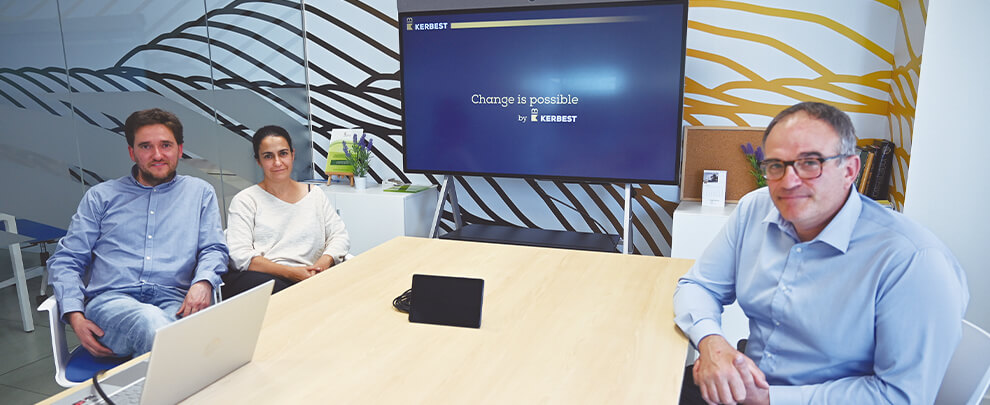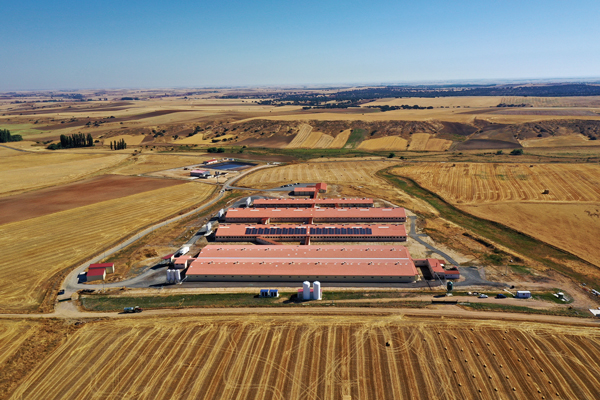Blog
Blog

Sustainability, Grangenia's key to achieving ISO 14001
13th December 2022 - News
Grangenia, one of the leading production centres of the Kerbest group from Avila, obtained an ISO 14001 certification in July, being the first farm of its kind to achieve this environmental distinction, which is another example of its commitment to sustainability, animal welfare and biosecurity in pork production. To know how this whole process has been, what it implies and what are the future challenges of the Kerbest group in this line of continuous improvement, we meet Alberto Pascual, executive director of the group, Pilar Fernández, director of biosafety and environment, and Álvaro García, technical director of development.
What does it mean to have received ISO certification in environmental management?
AG (Álvaro García): It is a recognition of the effort that has been made in terms of the environment, after years of work, especially by Pilar, whose effort has managed to strengthen one of our main pillars: sustainability and respect for the environment. This ISO recognizes that things are being done well and in a different way within the pork production sector.
AP (Alberto Pascual): On the one hand, there is a well-deserved recognition for the effort and dedication of the last 5-6 years since we established our sustainability strategy, but, above all, we understand that it means the beginning of a path towards the development of a new aspect of our companies, focused on ESG criteria, incredibly important when evaluating and perceiving institutions. We cannot stay on the sidelines and it is something vital if we want our farms to grow as corporations, something that, from this part of the sector we have been asking for, for many years now. We do not want to hide these things or make them up, we seek to professionalize ourselves, even more, to do things as well as possible. The truth is that the process of getting here has been very difficult. We spent two years without being able to certify an environmental management system because no certifier could do it. To certify a farm of 3,050 sows, with slurry, grids... it was an impossible mission, but, finally, we managed to make it feasible with AENOR.
You have also been one of the first pork production centres to achieve this distinction. Was it one of the goals when you designed Grangenia?
AP: Somehow, when Grangenia was made, we knew that we were going to do something different, for example, working with free maternities, with the recordable pits as trays, looking for the combination of forced and natural ventilation. Grangenia, therefore, was already a farm that was designed with a different aim in mind, in which to reflect what we wanted and then managed to improve with Kerbest. From there, we have been identifying the differentiating points of Kerbest over time, which has had them from the beginning, although perhaps we did not know how to name it.
PF (Pilar Fernández): Actually, we were not looking for Kerbest; the meaning comes from the best care in English (care best), with that idea of looking for the best for the animals, for our environment, for our region, for our peoples, in that special emptied Spain, in a sense. We wanted to make that synergy between livestock and a sustainable rural territory.
What requirements does Grangenia meet in order to receive this recognition?
AP: It is very important to raise awareness and involve the entire team, on the one hand, and on the other the digitalisation and protocolization of all production processes. You have to be very aware of what this certification means and especially what it means on a farm. The professional development policy of our staff is essential, directing it to the achievement of new very transversal competencies, necessary to achieve these certifications and meet the objectives we set. In this sense, we are very grateful to our entire team, whom we are very proud of and whom we thank for their dedication and commitment. On the other hand, as said, the digitalisation of the farm and its processes is basic. We have to generate traceability in all our processes, not only in the management of our slurry, and this has been possible thanks to our R+D, digitalisation and environmental departments. The work generating applications, platforms, sensors, protocols, etc has been huge. There is so much data that it cannot be collected manually. Therefore, we work with written protocols, which expedite our daily work. To lead several farms with multidisciplinary teams we need to have the necessary tools which will allow us to know every last cubic meter of slurry we produce in each of our production centres. And, it is all this information, all this data, that has allowed us to be awarded ISO 14001.
Can you list specific actions that you have encouraged to minimise the impact of your livestock activity?
PF: Specifically, in Grangenia and the rest of our piglet production farms, we implemented the Smartfert, which is our design for intelligent fertilization with which we optimize the transport of our slurry and customize the dose and type of purification depending on the characteristics of the soil, history of productions and cultivation to be implemented and then planted, thus optimizing the agronomic use of our slurry thanks to the fact that we extract the inefficient water from it with which we certify reductions in GHG emissions, between 600 and 1000 annual CO2 equivalent tons. Then we also set ourselves the goal of optimizing water management. In this area, we are aware that we cannot reduce the water consumption of animals, but we can reduce losses, reduce water for washing, and so on. And that's when we started to create new work protocols, to devise how we could improve the washing processes, prepare the rooms... reduce water consumption between 10-15% and, in the end, achieve a decrease of 25%. We did this by improving the management of cleaning work, with the purchase of a robot and with the training of the farm team which on their own provided improvements to save even more. On the other hand, and coming from the debate on how to save water consumption, the idea arose to collect rainwater and use it for washing, and so we do.

Aerial image of Grangenia. Photo: Kerbest.
What are the control and verification systems that these measurements do in order to obtain the certification?
AG: The main thing is to have all the data under control and be able to share it with the certifiers. What the external auditor does is certify and verify all the data that we provide and everything has to add up, that is, it has to be verifiable, quantifiable and measurable. From there on, the goal is to preserve the system and improve the data.
Can all commercial farms work towards this certification?
DP: You don't need to design a new farm to reduce emissions. Any farm can reinvent itself and get an environmental certification, what you have to do is have a different approach to what you are doing. We are now going to certify all our centres and those of our customers, so we are not talking about something for new farms only. It is not an essential condition.
And the industry, do you think it is prepared to take this step?
AP: The sector is increasingly prepared and there are more and more tools to make things easy, more technology, more sensors that allow you to monitor the data... Anyway, we have to keep in mind that we are in a sector in which change is costly, but when it gets on with it, it does things very well. So, I believe that the pork sector is going to take it and it is going to multiply it for sure, but everything has its time and its path. At first, change is difficult, but what I realise is that these changes save time, we are more efficient and there are also economic savings.
What improvements do you see for farmers with the addition of these procedures on their farms?
PF: More work comfort and more efficiency. For example, we had never looked at electrical consumption as we do now. By applying certain measures, we achieve efficiency gains and this often also means saving money and obviously, time. Digitization gives you all of this. It's a real impact, you just need to believe and want to change.
Can these sustainability certifications improve society's image of the sector?
AP: Without realising it, you are improving at the productive and image level. The job well done has its reflection and is what is transmitted afterwards. There is much more to what we do than what we can say. In the end, people, and society will see it. What this certification does is that it allows you to get that type of mark that easily guarantees a more sustainable production, because you already have everything certified. Although that is usually more of a marketers’ issue.
Does meeting all these requirements imply a large economic investment?
AP: Obviously, nothing is free, and there is an expenditure of money, time, awareness and commitment. However, the most important investment is intangible: the time and professionalisation you have to have, the training within the sector, that the team is aware of and wants to participate ... The rest is what you want to invest to meet the objectives you set, although there are also objectives that do not cost money.
AG: We would say that you have to invest to do things differently, but the good thing is that all these investments have a return on investment that, in addition, is seen in a short time, makes you sustainable and guarantees the future of livestock occupation.
What new challenges do you face by being increasingly sustainable and efficient?
AP: When we talk about sustainability, we are not only talking about the environmental aspect but also the social and economic and it is the combination of these three pieces that gives future viability not only to a company but to an entire sector. Contributing our grain of sand to the entire food chain is a great challenge, and do so in such a way that it returns greater sustainability multiplied "x" times to all the participants in that chain. If we focus on environmental sustainability, the following objectives are closely identified with energy efficiency and nutrient optimisation in organic fertilization, also acting in the all our centres’ processes in such a way that the implementation of this environmental certification and others like the Carbon Footprint certification that we have also seen materialised in recent weeks, suppose a standardised reality that adds to our model "by Kerbest”. Finally, the generation of knowledge is also a priority objective for Kerbest, in which the Cathedra in Agro-environmental Sustainability of the Kerbest Foundation is in sync with the Catholic University of Ávila. We are going to set goals. Where will we have the roof? Well, for now, we don't see it.






